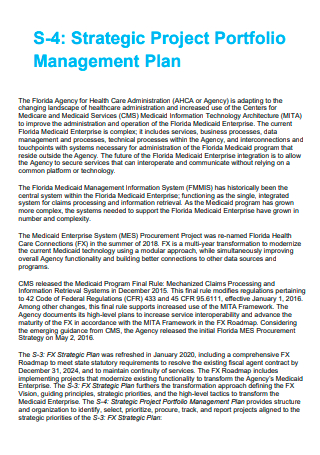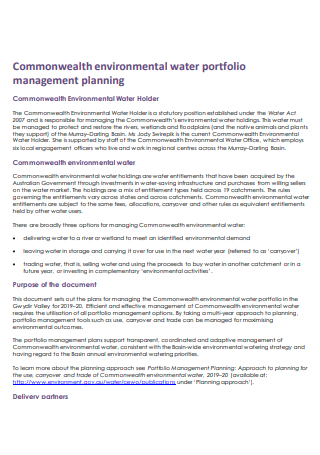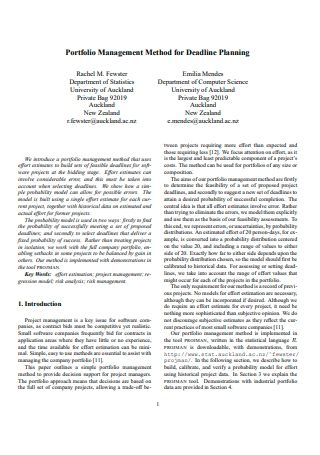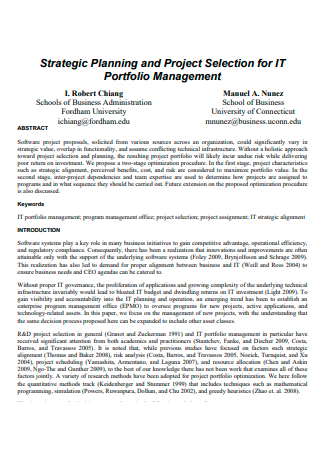4+ Sample Portfolio Management Plan
FREE Portfolio Management Plan s to Download
4+ Sample Portfolio Management Plan
What Is a Portfolio Management Plan?
Roles in a Portfolio Management Plan
Benefits of Effective Portfolio Management
Types of Portfolio Management
Steps in Portfolio Management
FAQs
What is a portfolio plan?
What does diversification mean in portfolio management?
What does a portfolio risk mean?
What Is a Portfolio Management Plan?
First of all, what is portfolio management? Well, it simply refers to the art and practice of choosing and supervising a set of investments that match a client’s long-term financial goals and risk tolerance. It also usually necessitates the capacity to assess qualities and shortcomings, opportunities and risks throughout the whole investment range. The final goal of managing a portfolio is to optimize the expected return of investment while appropriately exposing the investment to particular risks.
A portfolio management plan is a business document that helps manage multiple projects under a single portfolio and can be a massive help towards its collaboration, risk management procedures, and the accomplishment of objectives of the portfolio.
Roles in a Portfolio Management Plan
To effectively execute a portfolio management plan, a governance structure needs to be created in order to have members who have their respective roles in their organization concerning portfolio management. That being said, listed below are some of the roles which are broadly discussed.
Benefits of Effective Portfolio Management
Listed below are the benefits of effective portfolio management:
Types of Portfolio Management
Discussed below are the different types of portfolio management:
- Active Portfolio Management – active portfolio management entails actively purchasing and selling individual stocks and other assets in order to outperform an index. Closed-end funds of a portfolio are often managed aggressively. Active managers can use a variety of quantitative and qualitative models to help them evaluate possible investments.
- Passive Portfolio Management – this type of portfolio management believes that the fundamentals will always be represented in the price of the underlying asset. Passive solutions are frequently preferred by investors who want to minimize risk. The major advantage of passive investing is that it is the least expensive option to deploy. Passive techniques have also been shown to produce consistently high long-term returns. This type of portfolio management is also usually a one-time set-it-and-forget-it method.
- Discretionary Portfolio Management – The fund manager has entire control over their client’s investment decisions when using a discretionary approach to portfolio management. The discretionary manager makes all purchase and sale decisions on behalf of their customers and employs whichever approach they believe is optimal. The crucial advantage of this type of portfolio management is that you delegate all of your financial choices to a professional. This makes things a lot easier, especially if you approve of your manager’s purchase and sell recommendations.
- Non-Discretionary Portfolio Management – In this type of portfolio management, you make use of a non-discretionary portfolio manager who functions primarily as a financial advisor. They will provide you with the benefits and drawbacks of investing in a specific market or strategy, but they will not carry it out without your approval. This is the main distinction between a non-discretionary and a discretionary strategy. The fundamental advantage of non-discretionary portfolio management is that it allows you to consult with a financial professional without giving up control over your investment decisions.
Steps in Portfolio Management
If a portfolio is managed effectively, the right initiatives are implemented at the right time with the expected outcomes being achieved. With that being said, here are the steps needed to manage a portfolio effectively:
-
1. Ensure Work Visibility
This is the initial step that a portfolio manager usually does in managing a portfolio effectively. It is important to remember that in this step, it is critical to strategically identify and eliminate restrictions in order to improve the performance of a portfolio. It is possible if there are no bottlenecks and the product teams work in an atmosphere that allows clear insight into who is doing what and when it is delivered. With this knowledge, portfolio managers or leaders may simply identify interdependencies and hazards. They may publicly prioritize and allocate work so that the portfolio is not negatively impacted.
-
2. Make Customer’s Expectations a Priority
After establishing effective work visibility, the next thing to be done is to prioritize the expectations of the customers. This step needs to be done because organizations may wind up investing in less viable ventures if they do not have a well-thought-out portfolio prioritization strategy based on client objectives. In this step, it is also critical to distinguish between internal and external clients since they may have goals or expectations that are mutually incompatible or overlapping across many lines of business. An investment committee comprised of stakeholders from various departments may also be formed in this step to focus on the most beneficial ideas.
-
3. Adaptive Resource Management
The third step of the portfolio management process involves adaptive resource management. Flexibility, rather than strict planning processes, is the key to driving digital business towards success. An adaptive resource management strategy prioritizes resource allocation in response to market fluctuations and changing client demands. It is about building an environment in which resources may migrate between efforts easily to produce maximum value. However, in order for an adaptive strategy to be feasible, constraints affecting strategic coordination must first be recognized.
-
4. Continuous Delivering of Value
After choosing an adaptive resource management strategy, now is the time for this step of portfolio management to happen. This step is necessary since every single portfolio contains a promise of delivering value, and the consistent engagement of sponsors will assess if the promise of the portfolio is being lived up to the fullest or not.
-
5. Improving Your Culture
In this step, it is critical to know the importance of your work culture towards portfolio management. With today’s modern digital age, greater changes in business and technological operations have risen, which might have unforeseen repercussions and negatively impact customer relations and employee experiences. It is therefore critical to understand how to manage change successfully and how much change is far too much. Improving feedback and communication channels including corporate executives, managers, and end-users is the most crucial building component of an effective culture.
-
6. Realization of Benefits
This serves as the final part of effective portfolio management. To measure the actual advantages gained, a dedicated administrator should be in place. They will also improve their portfolio management skills by making more informed future decisions based on past failures. Should they fail to reap the promised advantages, they can simply evaluate business assumptions to see if there were any overestimations or if they missed any significant changes in market circumstances.
FAQs
What is a portfolio plan?
A portfolio plan refers to a written and graphical representation of what the portfolio consists of, its primary dependencies, estimated timelines, and significant deliverables, as well as a description of how the portfolio will be managed. Cost and benefit timelines, critical hazards, and main stakeholders are examples of supporting assessments.
What does diversification mean in portfolio management?
Diversification entails holding assets and asset types that are not highly connected. As a result, if one asset class falls, the other asset classes may not. This serves as a buffer for your portfolio. Furthermore, financial mathematics demonstrates that effective diversification may raise a portfolio’s total expected return while decreasing its riskiness.
What does a portfolio risk mean?
Portfolio risk refers to the possibility that the mix of assets or units in your investments may fail to satisfy financial objectives. In principle, good diversification may remove portfolio risk by owning permutations of investments that do not rely on the same variables to deliver a profit. In fact, though, the possibility exists that dangers are more likely to be reduced than removed totally.
Portfolio management serves as an essential part of the investing process, whether it is for the short-term or for the long term. As stated earlier, whenever a portfolio is successfully and effectively managed, the right initiatives/projects are delivered at the time when it is exactly needed, and as a result, the desired outcomes are therefore achieved. In this article, you can find examples of a portfolio management plan so that you have an idea of how it’s done.





